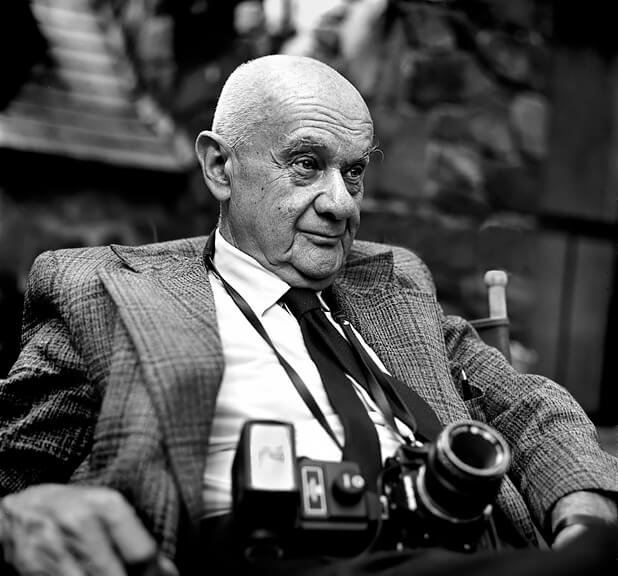Roman Vishniac was a Russian-American photographer, best known for capturing on film the culture of Jews in Central and Eastern Europe before the Holocaust. A major archive of his work was housed at the
International Center of Photography until 2018, when Vishniac's daughter, Mara Vishniac Kohn, donated it to
The Magnes Collection of Jewish Art and Life at the University of California, Berkeley.
Vishniac was a versatile photographer, an accomplished biologist, an art collector and teacher of art history. He also made significant scientific contributions to photomicroscopy and time-lapse photography. Vishniac was very interested in history, especially that of his ancestors, and strongly attached to his Jewish roots; he was a Zionist later in life.
Roman Vishniac won international acclaim for his photos of shtetlach and Jewish ghettos, celebrity portraits, and microscopic biology. His book
A Vanished World, published in 1983, made him famous and is one of the most detailed pictorial documentations of Jewish culture in Eastern Europe in the 1930s. Vishniac was also remembered for his humanism and respect for life, sentiments that can be seen in all aspects of his work.
In 2013, Vishniac's daughter Mara (Vishniac) Kohn donated to the
International Center of Photography the images and accompanying documents comprising ICP's
Roman Vishniac Rediscovered travelling exhibition.
In October, 2018, Kohn donated the Vishniac archive of an estimated 30,000 items, including photo negatives, prints, documents and other memorabilia that had been housed at ICP to the
Magnes Collection of Jewish Art and Life, a unit of the University of California at Berkeley's library system.
Source: Wikipedia
As the Nazis rose to power in Berlin, Vishniac photographed the ominous changes in the city and also worked to document Germany-Jewish relief and social service organizations. In 1935, the American Jewish Joint Distribution Committee (AJDC) hired Vishniac to travel to Eastern Europe and take photographs documenting Jewish poverty and relief efforts to be used in its fundraising campaigns. In 1939, Vishniac pursued other AJDC assignments in Western Europe and worked as a freelance photographer there. After the German invasion of France, he was arrested and sent to an internment camp. With help from the AJDC and the remainder of his family’s resources, he secured the release and immigrated with his wife and two children to the United States via Portugal in December 1940. They settled in New York, where Vishniac worked as a photographer, making portraits and documenting Jewish refugees and American-Jewish community life.
In 1947, Vishniac returned to Europe to document the aftermath of the war and the plight of refugees and those living in displaced persons camps. Back in the United States, Vishniac continued his work as photographer and scientist and became a pioneer in the new field of photomicroscopy.
Vishniac’s photographs of Jewish life in prewar Eastern Europe gained renown in the aftermath of the Holocaust and were used to illustrate numerous books. Many people today are familiar with his work from his book
A Vanished World (1983). However, the public saw only a small fraction of Vishniac’s work before his daughter, Mara Vishniac Kohn, entrusted his images to ICP and the Museum. This project makes them available to the public at large in hopes of learning more about the subjects of his photographs.
Source: Unites States Holocaust Memorial Museum
As an amateur photographer, Roman Vishniac took to the streets with his camera throughout the 1920s and ’30s, offering an astute, often humorous visual commentary on his adopted city and experimenting with new and modern approaches to framing and composition. Documenting the rise of Nazi power, he focused his lens on the signs of oppression and doom that soon formed the backdrop of his Berlin street photography.
From 1935 to 1938, while living in Berlin and working as a biologist and science photographer, he was commissioned by the American Jewish Joint Distribution Committee (JDC), then the world’s largest Jewish relief organization, to photograph impoverished Jewish communities in Central and Eastern Europe. On New Year’s Eve, 1940, he arrived in New York and soon opened a portrait studio. At the same time, he began documenting American Jewish communal and immigrant life and established himself as a pioneer in the field of photomicroscopy.
In 1947, Vishniac returned to Europe and documented Jewish displaced persons camps and the ruins of Berlin. During this time, he also recorded the efforts of Holocaust survivors to rebuild their lives and the work of the JDC and other Jewish relief organizations in providing them with aid and emigration assistance.
Source: International Center of Photography
